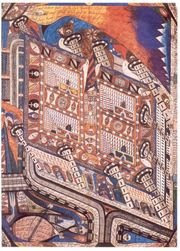 Must one be crazy? Mentally ill? Sick? To see the world with an odd tilt or from an unexpected perspective? I certainly hope not. Although, maybe it helps.
Must one be crazy? Mentally ill? Sick? To see the world with an odd tilt or from an unexpected perspective? I certainly hope not. Although, maybe it helps.To the left is a painting of the Pantheon & Luxembourg Gardens (1944) by Zelda Fitzgerald, wife of F. Scott Fitzgerald. She marched to her own beat, sought out risks, fought the established moral rules and barriers and battled mental illness her entire, short, life. In 1947 she died in a fire in the mental health institute where she was a patient. But she left behind a delightful collection of her art. Art that makes one look at things from a different angle. Allows artists to make their worlds tilt and whirl, allows still life to move and gives viewers more than one perspective at the same time.
According to an article "Mental Illness and Female Artists" by A.M. Ludwig, University of Kentucky: "The high rates of certain emotional disorders in female writers suggested a direct relationship between creativity and psychopathology. But the relationship was not necessarily a simple one. As the results of the predictive analysis indicated, familial and environmental factors also appeared to play an important role."
 Some call this association between mental illness and creativity the "Sylvia Plath Effect." We think of Virginia Woolf, Vincent Van Gogh, and composer Robert Schumann. Poets seem to be most at risk of being mentally ill, suicidal -- thus the Sylvia Plath reference. But whose to say that writing poetry didn't keep Sylvia sane and alive longer than if she had never picked up a pen?
Some call this association between mental illness and creativity the "Sylvia Plath Effect." We think of Virginia Woolf, Vincent Van Gogh, and composer Robert Schumann. Poets seem to be most at risk of being mentally ill, suicidal -- thus the Sylvia Plath reference. But whose to say that writing poetry didn't keep Sylvia sane and alive longer than if she had never picked up a pen?Terms like outsider art, alternative art, seems to reference artists who are a tad off plumb. Art created by insane asylum patients Raw or Brut Art of the 1920s drew much attention partly due to Dr. Walter Morganthaler's book Geisteskranker als Künstler (A Psychiatric Patient as Artist) on Adolph Wolfli. The book introduced Wolfli to the art world. (His Wölfli's Irren-Anstalt
 Band-Hain, 1910 is shown to the left).
Band-Hain, 1910 is shown to the left)."Morgenthaler's book was revolutionary in many ways as it was not simply a clinical study but argued that a person with a severe mental illness could be a serious artist and had the ability to make important contributions to the development of art."
Today, Outsider or Alternative Art may seem a little crazy but by no means does it signify that the artist is certifiably insane, crazy, suffering any mental disease whatsoever. You could draw your own conclusions perhaps -- but then who is to say what or who is normal? Deborah Eve Alastra's Fisherman (right) is considered Outsider Art, but does it comment on her state of mind? Today we have loosened up the boundaries of 'normal' and 'sane' and allow ourselves to experiment, take risks, 'raise the bar,' move the goal line' or whatever you want to call coloring outside of the lines. We trust our own sanity enough to explore the depths of our minds and emotions and subconscious. We put the results out there for others to see, learn and grow. And often to simply admire. So I say, "Go a little crazy with your art! It's healthy."

